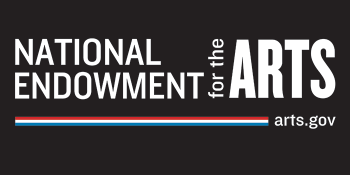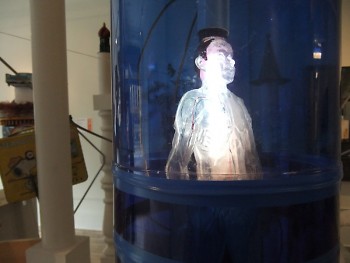Artist Kurt Kaiser, assemblage artist and faculty at Aquinas College, is an old pro at participating in ArtPrize. His first year, he showed "Carnival of Castoffs I" at 45 Ottawa, an independent venue that was normally just an empty building. I had the opportunity of getting to know Kurt after selecting his work for this space, which I was curating, that first year. Kaiser's first year was quite successful, and he was surprised to see himself at times listed in the Top 25 during the first round of voting.
I sat down with him recently to find out what he's up to this year with his entry "Carnival of Castoffs III," showing at CODA on 44 Division Street SE.
Holly Bechiri: Kurt, how did you come up with this idea?
Kurt Kaiser: I had made for a show at Meijer Gardens some years ago a very tall narrow piece, slightly more than 12 feet tall. When the exhibit was over, I didn’t have any place to put it, so I turned it horizontally and I built a kind of a harness for it that it rested on. So it hangs there from the ceiling in my office, and if you give it a push it will balance itself. That moved me into making a lot of balancing pieces that move. Since then, I’ve started applying motors to them. Even with the motors, the pieces still need to be well balanced, because otherwise it’s too much work for the motor. Especially since these motors were taken from other things: they were not meant for the particular job i’m giving them. I’m always on edge that they’re going to burn out. But if in the piece, the work they have to do is minimal -and it will be minimal if the part they’re moving is well balanced- then the likelihood of their burning out is less.
HB: Tell me about your process to make the piece.
KK: I had some pieces from an old gold-gilded coffee table, and it seemed to me that this would make a good foundation [for my sculpture]. Then I found some PVC pipe that I built onto it. I knew that I was going to have a lot of moving parts anchored to that. I’m very slow at anchoring the various moving parts [to the base] because I don’t want to get ahead of myself and make a decision which later I wish I had done it in a different direction. I’m inventing as I go along. Sometimes even when the piece is well underway, I will stumble upon this object that I just can’t pass up.
HB: How did you consider the context that your work was being created for?
KK: ArtPrize 2011 is the context for this work. More specifically, this little gallery CODA. I couldn’t pass up ArtPrize as an opportunity to exhibit. Often when there are show calls for entries to competitive shows, there are so many details that I have a hard time fulfilling. In this case, with ArtPrize, it was very free -as people can tell by walking around town, there’s a wide wide range of stuff that you could call art- and yet mine is still pretty conventional because it’s still pretty much an “object.” I’m really delighted to be showing in this gallery and I just wanted to make sure that people were able to see around the work, and the paintings on the wall as well.
HB: What are the strengths of your piece, would you say?
KK: What delights me about this piece that I’m creating is its very delight. The first time that I did ArtPrize -and all successive times- I included a list of all the many found objects that are in it, some that are very easy to see and others that are a little more subtle. I put a stack of such lists out there. People come by and they start to look for the items on that list, and they start to really enjoy the game of looking for all these things. As well, these many things are moving and they’re composed in a way that they were never intended to be composed, and they really delight the eye and sometimes even the ear. It’s a pleasure for me to stand back and watch people enjoying it and enjoying the game.
HB: What has your experience been like with ArtPrize?
KK: I could really easily launch into singing your praises... you know...
HB: (I laugh nervously.) We don’t need to do that.
KK: Okay, well then. The first year of ArtPrize, and the second also, it was really a joy to stand around and not really identify myself as the artist but to be there and see how people responded, and every once in a while for I don’t really know what reason people would identify me as the artist. They would ask questions and talk about it, and they always seemed extremely positive and seemed to really enjoy it. Then, months or years later, people are still telling me that. I did stop at someone’s house recently because they had set something out on the curb to give away. I don't usually grab stuff like that without knocking on the door, because people may have left stuff out there for some other reason. So I knocked on the door, and I told them that it might possibly be used for something in ArtPrize, and that I had been involved in previous years, and this fella said, "Oh I remember that! I’m going to come in and check it out!”
Kaiser's work, and watching him work with it, is a fascinating study in how an artist's mind works and the connections that they are making. Voters can visit the work during regular ArtPrize hours at CODA, 44 Division Street SE. Be sure to look for the science lab eyes peeking up and down behind their Mona Lisa peek-a-boo game, and see if you can spot the artist. He'll most likely be standing there with you, studying the parts and pieces.
The Rapidian, a program of the 501(c)3 nonprofit Community Media Center, relies on the community’s support to help cover the cost of training reporters and publishing content.
We need your help.
If each of our readers and content creators who values this community platform help support its creation and maintenance, The Rapidian can continue to educate and facilitate a conversation around issues for years to come.
Please support The Rapidian and make a contribution today.

